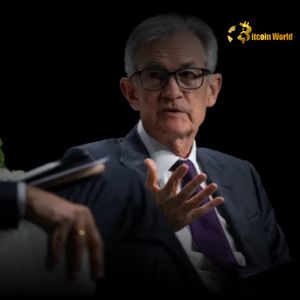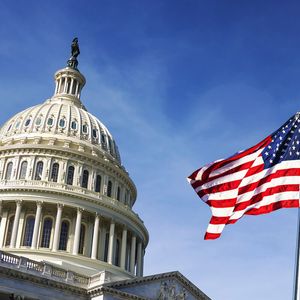Federal Reserve Holds Interest Rates: Why Tariffs Threaten Stable Inflation
6 min read
BitcoinWorld Federal Reserve Holds Interest Rates: Why Tariffs Threaten Stable Inflation For anyone navigating the dynamic world of cryptocurrencies and traditional finance alike, understanding the pulse of the US economy is paramount. And few entities dictate that pulse quite like the Federal Reserve . This week, all eyes are on the Fed as it signals its intention to keep Interest Rates steady, a decision that might seem straightforward but is underscored by complex concerns, particularly regarding the potential ripple effects of trade Tariffs on future Inflation . Why is the Federal Reserve Hitting the Pause Button on Interest Rates? Despite recent data showing mild inflation readings over the past few months – news that would typically pave the way for potential rate cuts or at least signal confidence – the Federal Reserve appears poised to maintain its current Interest Rates . The primary reason, as highlighted by reports, including one from the Wall Street Journal’s Nick Timiraos, centers on uncertainty surrounding trade policy and Tariffs . Here’s a breakdown of the Fed’s thinking: Recent Inflation Data: Consumer Price Index (CPI) and Personal Consumption Expenditures (PCE) data have shown a cooling trend, moving closer to the Fed’s 2% target. This *should* be good news. The Tariff Wildcard: Officials are wary that new or escalating Tariffs could disrupt supply chains, increase import costs for businesses, and ultimately lead to higher prices for consumers. Impact on Expectations: A key concern is how these potential price increases, driven by Tariffs , could influence consumer and business expectations about future Inflation . If people expect prices to rise significantly, it can become a self-fulfilling prophecy, making inflation harder to control. Cautious Approach: Given the unpredictable nature of trade disputes, the Fed prefers to wait and assess the actual economic impact before making any moves on Interest Rates . This cautious stance means the cost of borrowing for everything from mortgages to business loans is likely to remain unchanged for now, providing a degree of stability in one part of the financial landscape, even as trade policy injects uncertainty elsewhere. How Do Tariffs Potentially Fuel Inflation? It might not be immediately obvious how taxes on imported goods could affect the price of your morning coffee or the cost of building materials, but the link between Tariffs and Inflation is direct and significant. Think of a tariff as an extra cost added to goods as they cross a border. Consider these pathways for tariff-driven price increases: Direct Cost Increase: If a company imports components or finished goods, the tariff adds to their cost. Businesses often pass at least some of this increased cost onto consumers through higher prices. Example: A furniture retailer imports chairs from a country facing a 25% tariff. The cost per chair goes up. The retailer raises the selling price to maintain profit margins. Reduced Competition: Tariffs make imported goods more expensive, potentially reducing competition for domestic producers. With less pressure from foreign competitors, domestic companies may feel less need to keep their prices low. Supply Chain Disruption: Businesses may scramble to find alternative suppliers if imports become too expensive due to Tariffs . This can lead to temporary shortages or force them to use more expensive domestic alternatives, again driving up costs. Retaliation: When one country imposes tariffs, others often retaliate. This can hurt export-oriented industries in the US Economy , potentially leading to job losses or reduced investment, further complicating the economic picture. The Federal Reserve is particularly concerned about how widespread tariff impacts could shift the overall price level and, more importantly, people’s *expectations* about future prices. If businesses and consumers start believing inflation will be higher because of tariffs, they may adjust their behavior (e.g., demanding higher wages, raising prices proactively), embedding higher inflation into the US Economy . What Does This Mean for the US Economy and Beyond? The interplay between Interest Rates , Inflation , and Tariffs creates a complex forecast for the US Economy . The Fed’s decision to hold rates is an attempt to navigate these choppy waters, providing stability where it can while waiting for clarity on trade. Potential Impacts: Business Investment: Uncertainty around trade policy can make businesses hesitant to invest in new equipment or expansion, potentially slowing economic growth. Challenge: Businesses face unpredictable input costs and market access due to fluctuating tariff threats. Consumer Spending: Higher prices due to tariffs (even if gradual) can erode purchasing power. However, stable Interest Rates keep borrowing costs low, which can support spending on big-ticket items like cars and homes. Benefit (of stable rates): Lower borrowing costs for consumers and businesses. Global Trade: US tariffs and retaliatory measures disrupt global supply chains and trade flows, impacting not just the US but economies worldwide. Policy Effectiveness: Tariffs act like a tax and can be contractionary, potentially working against the stimulative effect of lower Interest Rates , making the Fed’s job of fine-tuning the economy more difficult. The Fed’s assessment involves sifting through conflicting signals: domestic demand might be solid, the labor market could be strong, but external shocks like trade wars introduce significant downside risks and upward price pressures simultaneously. Connecting the Dots: How Fed Decisions and Tariffs Impact the Crypto Market While the news about the Federal Reserve holding Interest Rates and assessing Tariffs might seem distant from your crypto holdings, these macroeconomic forces have significant indirect effects on digital assets. Here’s how: 1. Interest Rates and Liquidity: Lower or stable Interest Rates generally mean ‘cheaper’ money is available in the financial system. This increased liquidity can flow into various asset classes, including riskier ones like cryptocurrencies. Conversely, expectations of rising rates can tighten liquidity, potentially making traditional safe-haven assets more attractive and reducing appetite for volatility in crypto. The Fed holding rates is generally seen as neutral to slightly positive for risk assets compared to a rate hike. 2. Inflation and the Store of Value Narrative: Concerns about rising Inflation , whether from tariffs or other factors, can bolster the narrative of certain cryptocurrencies (like Bitcoin) as potential hedges or ‘digital gold’ against the devaluation of fiat currencies. If tariffs genuinely push up prices across the US Economy , the demand for perceived inflation hedges could increase. 3. Economic Uncertainty and Risk Appetite: Trade wars and economic uncertainty caused by Tariffs can lead to increased market volatility and a ‘risk-off’ sentiment among investors. In a risk-off environment, investors tend to move money out of volatile assets (like many cryptocurrencies) and into safer havens (like government bonds or gold). However, prolonged uncertainty can also lead some to explore alternative assets outside traditional systems, potentially benefiting crypto in the long run, albeit with short-term volatility. 4. Policy Spillover: The same economic conditions that influence the Federal Reserve ‘s monetary policy decisions can also indirectly influence regulatory approaches to finance and technology, including cryptocurrencies. A stable economic outlook might allow policymakers more room to focus on clear crypto regulation, while an unstable one might prioritize immediate economic fixes. Actionable Insight: For crypto investors, monitoring Fed announcements, inflation data, and major trade policy developments is crucial. These factors influence the broader economic backdrop that impacts market sentiment and liquidity, both key drivers for crypto price movements. Challenges and The Path Ahead The biggest challenge for the Federal Reserve right now is forecasting. Predicting the precise timing, scope, and economic impact of trade Tariffs is incredibly difficult. This uncertainty forces the Fed into a reactive or cautiously proactive stance rather than a clear, predictable path. The path ahead for the US Economy depends heavily on how trade negotiations evolve and whether tariff threats translate into sustained price increases. The Fed will continue to rely on incoming economic data – on inflation, employment, consumer spending, and business investment – to guide its future decisions on Interest Rates . This period highlights the interconnectedness of global trade, domestic economic policy, and financial markets. The Fed’s careful balancing act reflects the delicate state of the economy, poised between positive underlying strength and significant external risks. Compelling Summary In summary, the Federal Reserve is signaling a pause on Interest Rates , not because inflation is completely conquered, but because the potential impact of Tariffs looms large over future price stability. While recent Inflation figures have been encouraging, the unpredictable nature of trade policy introduces a significant risk of cost increases that could shift consumer and business expectations. This cautious approach aims to give the Fed time to assess the real-world effects of trade tensions on the US Economy . For those in the crypto space, these macro-level decisions are vital, influencing overall market liquidity, the appeal of inflation hedges, and general investor sentiment. Navigating this environment requires paying close attention not just to crypto charts, but also to the signals coming from central banks and trade negotiators worldwide. To learn more about the latest crypto market trends, explore our articles on key developments shaping the crypto market price action. This post Federal Reserve Holds Interest Rates: Why Tariffs Threaten Stable Inflation first appeared on BitcoinWorld and is written by Editorial Team

Source: Bitcoin World



